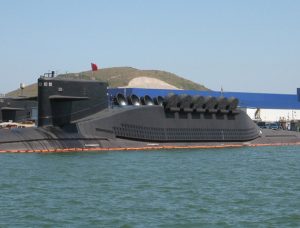China has built six Type 094, or Jin-class, nuclear ballistic missile submarines (SSBN), the U.S. Department of Defense’s 2019 annual report on Chinese military capabilities has confirmed. Four of the vessels are known to be operational while another two are being outfitted for operational deployment at the Huludao Shipyard in southwestern Liaoning Province in northern China.
“Over the past 15 years, the PLAN has constructed twelve nuclear submarines – two SHANG I-class SSNs (Type 093), four SHANG II-class SSNs (Type 093A), and six JIN-class SSBNs (Type 094),” the report noted. The Jin-class SSBNs form the sea leg of China’s nuclear triad and are capable of launching the JL-2 submarine-launched ballistic missile SSLBM).
“China’s four operational JIN-class SSBNs represent China’s first credible, sea-based nuclear deterrent,” the report noted. The Jin-class SSBNs were seen at the April 2018 fleet review of the People’s Liberation Army Navy conducted by Chinese President Xi Jinping, who also holds the title of commander-in-chief and chairman of the Central Military Commission.
Last year’s report acknowledged that four Jin-class submarines were operational, but did not acknowledge the construction of additional vessels. Open source analysts, however, noticed that China had more than four hulls constructed. One analysis found that at least five Jin-class hulls existed. Another claimed that Beijing had launched at least six and that “two additional” vessels had been specifically constructed at the Bohai Shipyard.
The Jin-class will likely remain at six vessels as China transitions to the Type 096 SSBN. “China’s next-generation Type 096 SSBN reportedly will be armed with the follow-on JL-3 SLBM, and it will likely begin construction in the early2020s,” the Pentagon’s report noted. “Based on the 40-plus-year service life of China’s first generation SSNs, China will operate its JIN and Type 096 SSBN fleets concurrently.”
China has undertaken flight-testing of the JL-3 SLBM. The first test of the JL-3 took place on November 24, 2018, and was an ejection test followed by a short duration of actual flight. “The first flight test likely verified the system’s proper cold ejection from the submarine-based launch tube,” The Diplomat noted at the time.
China does not today possess a true nuclear triad. The People’s Liberation Army Air Force, while having been reassigned a nuclear mission last year, does not currently field any nuclear-capable weapons. According to the U.S. Department of Defense’s assessment, a new nuclear-capable air-launched ballistic missile, when fully developed and fielded, will complete China’s triad by giving it an air-launched nuclear capability.
Most of China’s nuclear force is composed of ground-based ballistic missiles.

































